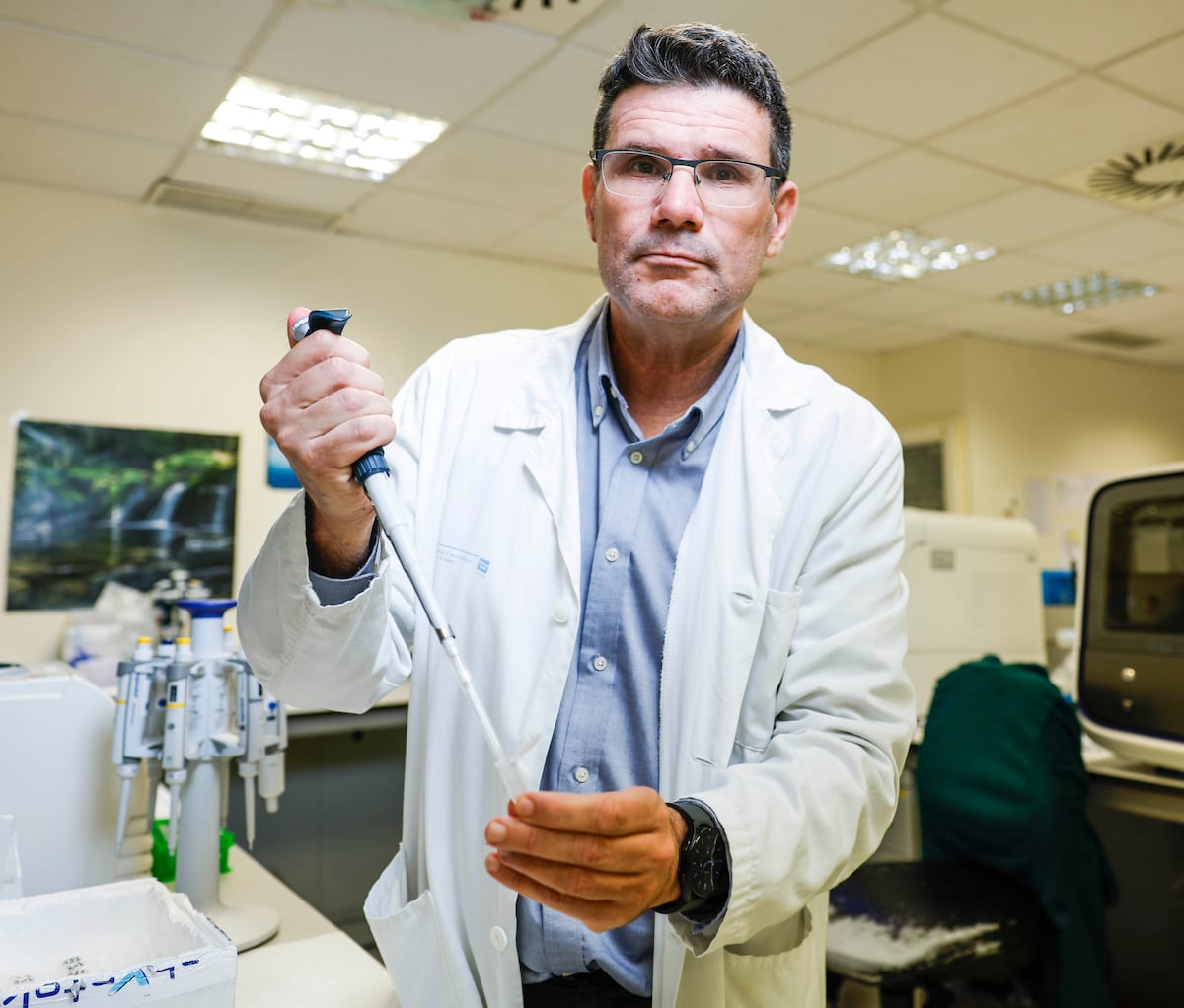
For a few years now, talking about miraculous cures in cancer has not only been possible, but has become increasingly common. The revolutionary therapy known as CAR-T has allowed thousands of people with blood tumors to live for years, even more than a decade, without a trace of cancer. The challenge now is to help people with solid tumors, which are much more complex and lethal. Among all of them, brain glioblastoma stands out, an incurable cancer against which there has been little progress in 20 years.
The neurologist Juan Manuel Sepúlveda, son of a nurse and a rancher from Becerril de la Sierra, 45 kilometers from Madrid, tells why glioblastoma is such an untreatable tumor. Malignant cells look very similar to healthy ones, it is very difficult to develop drugs capable of entering the brain, and despite surgery and radiotherapy, relapse is practically certain. “In the brain,” he adds, “a tumor of a few millimeters can radically change your life, causing you to not be able to speak or understand others, something that does not happen with other tumors, in which the patient can be removed. part of the organ and continue leading a normal life.” “There have been many clinical trials against glioblastoma, but we have not been able to stop it,” he acknowledges.
Sepúlveda leads a project funded with 1.4 million euros by the Carlos III Health Institute to carry out the first clinical trial in Europe with a new variant of CAR-T designed specifically to attack and defeat this devilish neurological tumor.
“Our intention is to cure it,” explains the doctor. “Unlike other oncology treatments, such as chemo or immunotherapy, CAR-Ts either work to cure, or they don’t work.” This neurologist specialized in oncology will lead a team of 25 people from the Hospital 12 de Octubre, in Madrid, to test the new therapy on up to 15 patients. The project takes advantage of the knowledge already existing at this hospital, where cell therapies have already been developed for hematological cancers, including leukemias in young patients and lymphomas in adults.
These treatments are so refined that they seem like science fiction. In essence, CAR-T are lymphocytes, a type of white blood cell specialized in chasing, attacking and destroying any pathogen. In these treatments, normal lymphocytes are extracted from the patient’s blood and infected with a harmless retrovirus that embeds itself in the patient’s genome. This modification gives them a new capacity: to exclusively identify the molecules present on the surface of tumor cells. Scientists cultivate this new army of specific lymphocytes in the laboratory, which becomes increasingly numerous. At the end of the process, several million of these trained cells travel in a few milliliters of injection to locate and eliminate the tumor.
CAR-Ts work very well against blood tumors because most of them exhibit the same characteristic molecules to attack. However, solid cancers are much more diverse and are also protected by a complex microscopic wall that hides them from the immune system.
15 years ago, a Finnish scientist named Erkki Ruoslahti discovered p32, a protein present in the outer membrane of glioblastoma cells and other solid cancers. Fortunately, p32 is only expressed in healthy cells within the mitochondria, an internal organelle that lymphocytes are unable to locate or attack. October 12 oncologist Luis Álvarez-Vallina has collaborated with Ruoslahti and Dinorah Friedmann-Morvinski, from Tel Aviv University, to develop CAR-Ts specialized in targeting this protein. In 2021, they demonstrated in a study in mice that these new CAR-Ts reduced the size of brain glioblastomas.
“It is a very interesting concept that opens the door to using these technologies in solid tumors with sufficient safety,” explains Álvarez-Vallina, who co-leads the Madrid project. The plan is to carry out new studies with animals this year to confirm the safety of the treatment and begin a clinical trial in patients when they have permission from the Spanish Medicines Agency, probably in 2026. The CAR-Ts would be administered directly to the tumor area. after surgery. If a therapeutic effect is demonstrated, subsequent studies could improve the ability of lymphocytes to identify and kill tumor cells, adds Álvarez-Vallina.

In the United States, these new cell therapies have shown positive results in preliminary trials with patients. A team from the University of Pennsylvania, where CAR-Ts were invented, showed in March that a variant of this therapy directed against two proteins — EGFR and interleukin 13 alpha 2 receptor — reduced the size of tumors in six patients with glioblastoma, and the effect was maintained over time in several of them.
Oncologist Stephen Bagley, one of those responsible for the trial, explains in an email that they have already treated three other patients with similar results. “The big question now is whether this reduction in tumors can be maintained over time. We see that some of those treated are obtaining a clinical benefit, and others in which the effects are transitory,” he details. One of the objectives is to identify the profile of patients who do respond to treatment to carry out larger trials. Another similar project led by Massachusetts General Hospital with a combined CAR-T also detected positive preliminary effects in several patients. These works replicate in humans the first observations in animal tests, which have resurrected a field of research in which there were hardly any options left.
“It is the first time that there is a clear opportunity to cure this incurable tumor,” recognizes immunologist Manel Juan, from the Hospital Clínic of Barcelona. His team has received about two million euros from Carlos III to begin another clinical trial with CAR-T in pediatric glioma, a brain tumor equivalent to adult glioblastoma in which no patient survives more than two years, highlights Juan.
This approach consists of diversifying the immune army that is launched against the tumor. First, dendritic cells of the immune system are generated, sensitized to proteins characteristic of the tumor and reinfused into the patient, as if they were a vaccine. Once the immune response begins, doctors draw blood from the patient again, isolate their lymphocytes, which have already learned to identify the tumor, and genetically modify them to give them the ability to detect a new protein that is expressed only in the cells. malignant — again the interleukin 13 alpha 2 receptor. “These tumors always look for an escape route and relapses are frequent. If you use only one product, the results may not be curative. For the tumor to escape two or three different receptors is much more difficult. And eventually an effective combination will be achieved,” explains Juan. This, in turn, may allow expanding the field of CAR-T to other very lethal solid tumors for which there are no effective treatments, such as those of the pancreas, and also others with poor prognosis subtypes. An impediment for these technologies is that the safety of each of the components must be demonstrated separately, something that was not done in the past with chemotherapy treatments, adds Juan.
If these treatments end up being successful, a debate that is difficult to resolve will be reopened. Commercial CAR-Ts cost about 300,000 euros per patient, a sum within the reach of few health systems. In addition, solid tumors may not be cured with a single treatment and lymphocytes must be injected periodically to maintain the effect. Experimental trials in public hospitals allow the cost to be reduced somewhat, around 100,000 euros per patient in the case of October 12, but only for a few patients. If the treatment demonstrates effectiveness, the entry of the pharmaceutical industry will be necessary, which is the only one with sufficient resources and facilities to systematize production. A couple of years ago, Carl June, creator of the first CAR-T therapy, recognized that this is a problem that only politics can solve. “Citizens pay with their taxes for the development of these treatments, in academic centers, and then end up paying again to receive the therapy.”
You can follow SUBJECT in Facebook, x and instagramor sign up here to receive our weekly newsletter.

